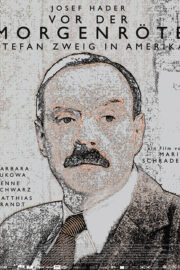Farewell to Europe
The film relates episodes from Austrian writer Stefan Zweig’s life in exile. At the height of his worldwide fame, he was driven to emigrate and despaired over the downfall of Europe, which he had foreseen early on.
It is the story of a refugee, the story of losing one’s former home and searching for a new one. Rio de Janeiro, Buenos Aires, New York, and Petrópolis were four stations of Stefan Zweig’s exile which, despite providing a safe refuge, a hospitable reception, and a stunning natural world in the tropics, did not grant him peace and could not replace his homeland.
Cast
- Stefan Zweig
- Josef Hader
- Claudio de Souza
- João Lagarto
- Minister Soares
- Virgílio Castelo
- Leopold Stern
- NIcolau Breyner
- Alzira Vargas
- Cristina Do Rego
- Jandira Vargas
- Larissa Offner
- Samuel Malamud
- Lenn Kudrjawizki
- Mrs de Souza
- Suely Torres

Farewell to Europe
Maria Schrader
- Fiction
- Production Country / Year
- Germany 2016
- Language
- dt., engl., ru., pt., frz., span. OF m. dt. UT
- Format
- DCP, Color, 106min
2.39:1, Discrete 5.1
- Original Title
- Vor der Morgenröte
Director & Crew
Maria Schrader
“He (Stefan Zweig) had escaped the war and yet he was haunted by it. He could not stop imagining everything that was happening at the same time at the far end of the world. This empathy and this sensitivity were extraordinary human qualities that helped him achieve fame as a writer but also became his undoing in life. [...] It was intended as a film about exile, told through the example of Stefan Zweig. Zweig himself, with his Sternstunden der Menschheit, wrote the most beautiful example of miniatures that suddenly reveal something larger, something transcendent. Guided by this spirit, we developed the idea of choosing six very different moments from Zweig’s life, including prologue and epilogue, to which we could devote ourselves in their complexity without having to force them into a causal context. Perhaps the time one suddenly has, the details one can then recount, creates more of an opportunity to immerse oneself in situations. Despite all the omissions, the result is an impression that is not so much broad as deep – at least we hope so.”
Maria Schrader
- Writer
- Maria Schrader
- Jan Schomburg
- Director of Photography
- Wolfgang Thaler
- Editor
- Hansjörg Weissbrich (BFS)
- Production Designer
- Silke Fischer
- Costume Designer
- Jürgen Döring
- Sound
- Philippe Garnier
- Music Composer
- Tobias Wagner
- Make-up
- Monika Fischer-Vorauer
- Andreas Meixner
- Producer
- Stefan Arndt
- Uwe Schott
- Pierre-Olivier Bardet
- Danny Krausz
- Denis Poncet